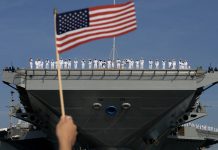After calling it an innocent ‘passage’, the US has further toned down the controversy surrounding its naval operation in India’s exclusive economic zone (EEZ) off the Lakshadweep coast last week. Chinese experts have termed the whole episode as a “QUAD dilemma”.
“On April 7, the USS John Paul Jones, part of the US Navy Seventh Fleet, conducted a routine Freedom of Navigation Operation in the Indian Ocean. This operation demonstrates longstanding US support for international law and freedom of the seas worldwide,” a US Department of Defense spokesperson has said.
“We value our partnership with India on a wide range of issues, including regional security across the Indo-Pacific,” the spokesperson said.
US destroyer John Paul Jones had carried out what it called a “freedom of navigation” operation in the Indian EEZ, triggering a protest from New Delhi.

“The Government of India’s stated position on the United Nations Convention on the Law of the Sea is that the Convention does not authorize other States to carry out in the Exclusive Economic Zone and on the continental shelf, military exercises or manoeuvers, in particular those involving the use of weapons or explosives, without the consent of the coastal state,” India’s Ministry of External Affairs said in a statement on April 9.
It further said the USS John Paul Jones was continuously monitored transiting from the Persian Gulf towards the Malacca Straits. “We have conveyed our concerns regarding this passage through our EEZ to the Government of U.S.A through diplomatic channels,” the statement read.
On April 11, the Pentagon termed the mission as “innocent passage” in a bid to project it as a non-military exercise.
However, Chinese experts were quick to label the controversy as a dilemma over the QUAD grouping. Quadrilateral Security Dialogue or QUAD, which comprises the US, Australia, Japan, and India, has been formed to counter China’s aggressive posture in the Indo-Pacific region.
The US-led bloc has recently held its first-ever summit of its leaders, during which the member-states pledged to uphold freedom of navigation in international waters, a reference to the Chinese muscle-flexing in the disputed South China Sea.
However, the Chinese analysts see the latest India-US controversy as a potential rift among QUAD allies.
“The US Navy’s intrusion into India’s EEZ…will strengthen India’s strategic doubt toward the US and make it believe that its firm refusal to let Quad evolve into a NATO-like military alliance in Asia is a wise choice,” Xie Chao, a Chinese analyst wrote in the state-owned Global Times.
Xie, an assistant professor at the Institute for International and Area Studies, Tsinghua University, argues that India, which is a key member of QUAD, may not like to play a secondary role in the bloc while the US would not allow it “to sit with it on an equal footing”.
This could create a rift between the two, which could prompt India to turn towards its trusted military ally Russia. The timing of the India-US row is important given that India seems determined to pursue its S-400 air defense deal with Russia despite strong reservations from Washington.
So, one could see the USS naval operation in an Indian EEZ as a further warning by the Biden administration against the S-400 deal. But then, Russian Foreign Minister Sergei Lavrov was in New Delhi last week, and he said in no uncertain terms that there could be a “reciprocal reaction” if Washington “overtly” asks countries to desist from signing weapons agreements with Moscow.
“It wasn’t me who said the US exercised pressure on India but any other country which wanted to sign an agreement with Russia on the delivery of weapons… If the US says this overtly, we all will know, but we also know the reciprocal reaction,” Lavrov told reporters in New Delhi.




